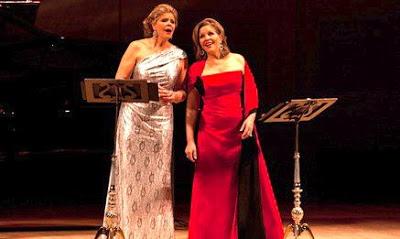by Paul J. Pelkonen

Susan Graham and Renée Fleming. Susan is the tall one.
Photo by Melanie Buford © 2013 National Public Radio/WQXR.
Ms. Fleming and Ms. Graham don't always appear together, but their careers are inextricably linked. They made early recordings together, like Handel's Alcina. In 2000 and 2009, they melted earts at the Met in Richard Strauss' sentimental comedy Der Rosenkavalier (Ms. Graham takes the trouser part.) However, the opportunity to see these two divas in a concert collaboration is rare indeed.
The program opened with three songs by Camille Saint-Saëns. The black-gowned singers paused between numbers to explain that their intent was to recreate a salon atmosphere in the unlikely space of Stern Auditorium. Somehow, the interaction of their voices created that needed sense of intimacy as they soared through the long phrases of "Pastorale" and the rapid Spanish rhythms of "El desdichado."
Next up: four songs by Gabriel Fauré. He is best remembered for his Requiem but also wrote songs that are the bread and butter of every vocal student. That long experience showed in the languors of "Pleurs d'or", the intertwining, sharp dialog of the Pavane and the riotous "Tarantelle." In this last song, Ms. Fleming and Ms. Graham moved their music stands together and engaged in a playful competition of vocalise and coloratura.
An exploration of Debussy followed. Pianist Bradley Moore appeared alone under dimmed lights. He played a slow Clair de lune with languid phrases, although one wished for more propulsion in the latter pages. cendingMs. Fleming then returned to sing two early, charming Debussy songs, followed by Léo Delibes' Les filles de Cadix. The soprano's voice sounded taut as she navigated that song's tricky intervals.
The second half started with four songs by Reynaldo Hahn, the French composer whose work has been a staple of Ms. Graham's repertory for her whole career. This was a gorgeous miniature set, highlighting the smoky colors of her lower range, giving way to bright sunlight as she rose into her upper register.
Ms. Graham had already given up the black dress for a sparkling silver sheath. She was then joined by Ms. Fleming, a study in scarlet. ("Two divas, you get four gowns," the mezzo quipped.) The two singers then launched into an unusual duet arrangement of Berlioz' La Mort d'Ophélie, an adaptation of Shakespeare that recounts the tragic fate of the heroine of Hamlet. As before, Ms. Fleming sounded at her best when expertly supported by Ms. Graham, the two voices together forming one extraordinary instrument.
The concert ended with operatic selections. They led off with Messager's comic "Blanche-marie et Marie-Blanche" a souffle of impressive vocal fireworks by operetta composer André Messager. This was followed by the Barcarolle from Les Contes d'Hoffmann with Ms. Graham's Nicklausse flirting with Ms. Fleming's Giulietta. The finale was the "Flower duet" from Délibes' Lakme, with priestess and acolyte singing lyric, melting phrases to Mr. Moore's subtle accompaniment.
Of course, there were encores. The singers celebrated Mozart's 257th Prenderò quel brunettino" from Cosí fan tutte, an opera (they confessed) that they'd love to do together some day. Then, Ms. Graham came out with a cigarette dangling from her lip (Reynaldo Hahn-style) and sat down at the piano herself. She then delivered a sultry version of "La vie en rose," employing the lowest end of her register for this classic torch song. However this was not mimicry, it was interpretation. The biggest surprise: the lady is a superb, stylish pianist.
Then it was Ms. Fleming's turn. She countered with Malurous Qu'O Uno Fenno from Canteloube's Songs d'Auvergne. Its light, playful delivery was the perfect antithesis to Ms. Graham's ballad. The two singers then returned for one last treat, the Evening Prayer from Act II of Humperdinck's Hansel und Gretel. It was a perfect ending to hear these two singers again in German, the language which somehow seems to suit their voices best.

